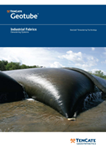Geotube®
Industrial Wastewater Processing
TenCate Geotube® technology provides cost-effective and sure dewatering and containment in a wide variety of industries.
TenCate Geotube® dewatering technologyprovides cost-effective and sure dewatering and containment in a wide variety of industries. A common problem at small sewage treatment works where sludge is dried on drying beds, is that the limited capacity of the beds can easily be exceeded. This could be due to an increase in sludge quantity resulting from increasing population.
TenCate Geotube® dewatering technology is increasingly being used as a means of both simplifying the sludge dewatering process and effectively increasing the volume of the drying beds. In the past, the drying beds had to be emptied at regular intervals, the time for a complete fill of the Geotube® unit can be increased to several months. A significant saving can therefore be made in terms of handling and transportation.
After the sludge has been treated with a flocculant it is pumped into the Geotube® unit where the sediments remain and the water seeps through the pores of the tube. This process can be repeated over and over again until the Geotube® unit reaches its maximum level.
Dewatering for Wastewater Treatment Plants
Geotube® Dewatering units are indeed a valuable asset for dewatering biosolids at any wastewater treatment plant (WWTP). The technology has distinct advantages over drying bed, centrifuge, and belt filter press systems in the areas of cost, maintenance, risk and scalability. The large porous Geotube® Dewatering containers are designed to efficiently retain solids and allow fluids to pass. It is a complete dewatering solution that can be used in conjunction with in-place systems to provide redundancy during planned and unplanned downtime.
Benefits of TenCate Geotube® Dewatering Technology:
Cost
- According to US EPA cost estimates of Belt Filter Press and Centrifuge operation, continuous Geotube® Dewatering operation is more cost effective by a large factor.¹ ²
- Upfront capital cost of Geotube® Dewatering is minimal and caparable to drying beds
Maintenance
- Geotube® Dewatering units require minimal maintenance cost and limited on-site expertise
- Centrifuge and Belt Filter technology rely on critical components which often requires additional labour time
Scaling
- Geotube® Dewatering units can be easily scaled from 1m³ biosolid storage to 1000+m³ biosolid storage
- Due to its scalability, Geotube® Dewatering units can readily meet the needs of a growing WWTP including future upgrades of major WWTP components
Risk
- Weather is unpredictable. Unlike drying beds, Geotube® Dewatering units can be relied on in all weather conditions
- In practice, lagoons and drying beds are often pushed near or beyond their safe operating capacity due to cost or other constraints of up-scaling
- Centrifuge and Belt Filter Presses rely on complex equipment which are subject to expensive and time consuming repairs in the event of component failure. Geotube® Dewatering units rely on simple, interchangeable components such as pumps and valves
Redundancy
- Any WWTP will benefit from the redundancy offered by a supplementary or backup Geotube® Dewatering solution
-
Geotube® Dewatering is a viable solution to the risk of planned or emergency downtime of in-use dewatering components
¹ United States Environmental Protection Agency. Office of Water, Washington DC Biosolids Technology Fact Sheet - Belt Filter Press. September 2000
² United States Environmental Protection Agency. Office of Water, Washington DC Biosolids Technology Fact Sheet - Centrifuge Thickening and Dewatering . September 2000
Download Resources

TenCate Geotube® Dewatering - Industrial Fabrics Brochure
Other Environmental Remediation Applications
Need more information?
At TenCate our goal is your success. If you have any questions or would like to learn more, please contact us.








